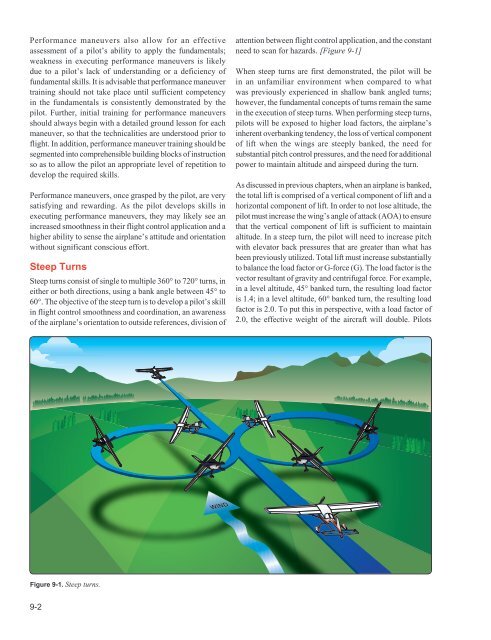Create successful ePaper yourself
Turn your PDF publications into a flip-book with our unique Google optimized e-Paper software.
Performance maneuvers also allow for an effective<br />
assessment of a pilot’s ability to apply the fundamentals;<br />
weakness in executing performance maneuvers is likely<br />
due to a pilot’s lack of understanding or a deficiency of<br />
fundamental skills. It is advisable that performance maneuver<br />
training should not take place until sufficient competency<br />
in the fundamentals is consistently demonstrated by the<br />
pilot. Further, initial training for performance maneuvers<br />
should always begin with a detailed ground lesson for each<br />
maneuver, so that the technicalities are understood prior to<br />
flight. In addition, performance maneuver training should be<br />
segmented into comprehensible building blocks of instruction<br />
so as to allow the pilot an appropriate level of repetition to<br />
develop the required skills.<br />
Performance maneuvers, once grasped by the pilot, are very<br />
satisfying and rewarding. As the pilot develops skills in<br />
executing performance maneuvers, they may likely see an<br />
increased smoothness in their flight control application and a<br />
higher ability to sense the airplane’s attitude and orientation<br />
without significant conscious effort.<br />
Steep Turns<br />
Steep turns consist of single to multiple 360° to 720° turns, in<br />
either or both directions, using a bank angle between 45° to<br />
60°. The objective of the steep turn is to develop a pilot’s skill<br />
in flight control smoothness and coordination, an awareness<br />
of the airplane’s orientation to outside references, division of<br />
attention between flight control application, and the constant<br />
need to scan for hazards. [Figure 9-1]<br />
When steep turns are first demonstrated, the pilot will be<br />
in an unfamiliar environment when compared to what<br />
was previously experienced in shallow bank angled turns;<br />
however, the fundamental concepts of turns remain the same<br />
in the execution of steep turns. When performing steep turns,<br />
pilots will be exposed to higher load factors, the airplane’s<br />
inherent overbanking tendency, the loss of vertical component<br />
of lift when the wings are steeply banked, the need for<br />
substantial pitch control pressures, and the need for additional<br />
power to maintain altitude and airspeed during the turn.<br />
As discussed in previous chapters, when an airplane is banked,<br />
the total lift is comprised of a vertical component of lift and a<br />
horizontal component of lift. In order to not lose altitude, the<br />
pilot must increase the wing’s angle of attack (AOA) to ensure<br />
that the vertical component of lift is sufficient to maintain<br />
altitude. In a steep turn, the pilot will need to increase pitch<br />
with elevator back pressures that are greater than what has<br />
been previously utilized. Total lift must increase substantially<br />
to balance the load factor or G-force (G). The load factor is the<br />
vector resultant of gravity and centrifugal force. For example,<br />
in a level altitude, 45° banked turn, the resulting load factor<br />
is 1.4; in a level altitude, 60° banked turn, the resulting load<br />
factor is 2.0. To put this in perspective, with a load factor of<br />
2.0, the effective weight of the aircraft will double. Pilots<br />
WIND<br />
Figure 9-1. Steep turns.<br />
9-2


